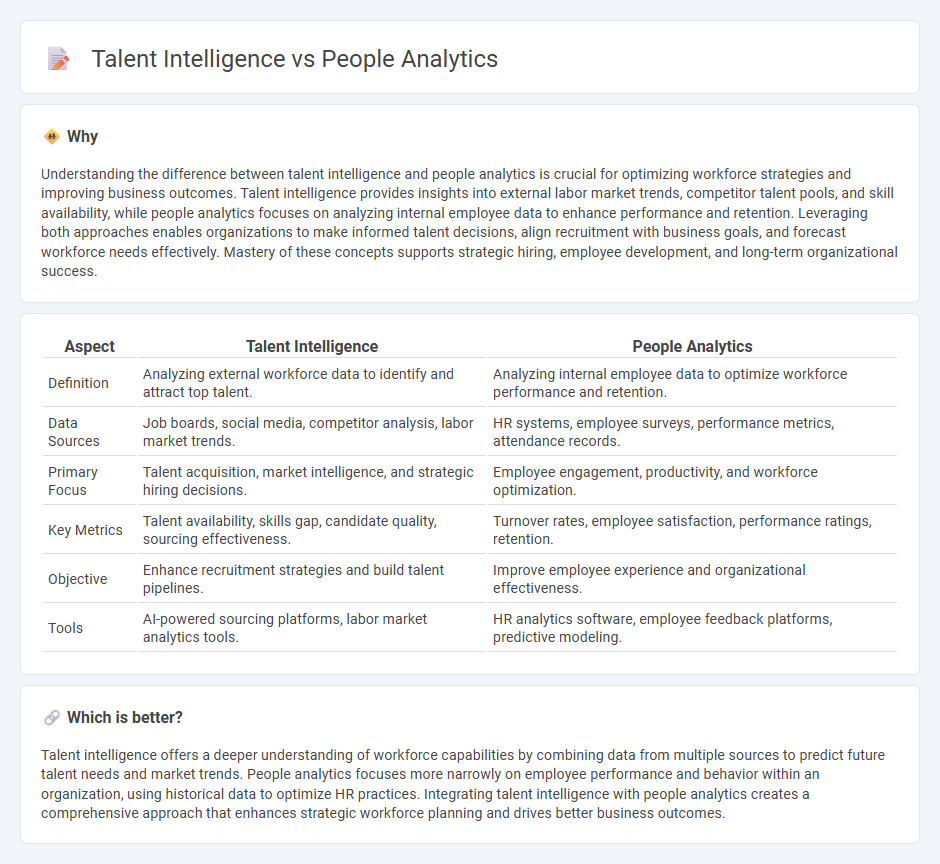
Talent intelligence leverages advanced data analysis and market insights to identify and attract top candidates, enhancing strategic workforce planning. People analytics focuses on internal employee data to improve engagement, productivity, and retention within an organization. Explore how combining both approaches can revolutionize your talent management strategies.
Why it is important
Understanding the difference between talent intelligence and people analytics is crucial for optimizing workforce strategies and improving business outcomes. Talent intelligence provides insights into external labor market trends, competitor talent pools, and skill availability, while people analytics focuses on analyzing internal employee data to enhance performance and retention. Leveraging both approaches enables organizations to make informed talent decisions, align recruitment with business goals, and forecast workforce needs effectively. Mastery of these concepts supports strategic hiring, employee development, and long-term organizational success.
Comparison Table
| Aspect | Talent Intelligence | People Analytics |
|---|---|---|
| Definition | Analyzing external workforce data to identify and attract top talent. | Analyzing internal employee data to optimize workforce performance and retention. |
| Data Sources | Job boards, social media, competitor analysis, labor market trends. | HR systems, employee surveys, performance metrics, attendance records. |
| Primary Focus | Talent acquisition, market intelligence, and strategic hiring decisions. | Employee engagement, productivity, and workforce optimization. |
| Key Metrics | Talent availability, skills gap, candidate quality, sourcing effectiveness. | Turnover rates, employee satisfaction, performance ratings, retention. |
| Objective | Enhance recruitment strategies and build talent pipelines. | Improve employee experience and organizational effectiveness. |
| Tools | AI-powered sourcing platforms, labor market analytics tools. | HR analytics software, employee feedback platforms, predictive modeling. |
Which is better?
Talent intelligence offers a deeper understanding of workforce capabilities by combining data from multiple sources to predict future talent needs and market trends. People analytics focuses more narrowly on employee performance and behavior within an organization, using historical data to optimize HR practices. Integrating talent intelligence with people analytics creates a comprehensive approach that enhances strategic workforce planning and drives better business outcomes.
Connection
Talent intelligence and people analytics are interconnected through their focus on leveraging data to optimize workforce management and decision-making. Talent intelligence gathers comprehensive information on employee skills, performance, and potential, while people analytics analyzes this data to identify trends, predict outcomes, and enhance talent acquisition and retention strategies. Together, they empower organizations to make evidence-based talent decisions that improve productivity and competitive advantage.
Key Terms
Data-driven Decision Making
People analytics harnesses employee data to optimize workforce performance and engagement, utilizing metrics such as turnover rates, productivity scores, and employee satisfaction surveys. Talent intelligence integrates external market data with internal workforce insights to enhance recruitment strategies, talent mapping, and competitive benchmarking. Explore the distinctions and applications of both to elevate your data-driven decision-making approach in HR.
Predictive Analytics
Predictive analytics in people analytics harnesses employee data to forecast workforce trends, enhancing talent management and retention strategies through data-driven insights. Talent intelligence integrates predictive algorithms with external market data to identify future skill gaps and optimize recruitment pipelines, providing a competitive advantage in talent acquisition. Explore deeper insights on how predictive analytics transforms strategic human resource planning by learning more about people analytics and talent intelligence.
Workforce Planning
People analytics leverages data-driven insights to understand employee behavior, performance, and engagement, enhancing decision-making in workforce planning. Talent intelligence combines external market data with internal analytics to identify skill gaps, forecast talent needs, and build strategic workforce pipelines. Explore how integrating these approaches can optimize your workforce planning strategies effectively.
Source and External Links
What Is People Analytics and How Do I Get Started? - Visier - People analytics is the practice of collecting and transforming HR and organizational data into actionable insights that improve business decisions, using data from digital HR tools combined with algorithms and machine learning to provide actionable insights beyond basic reporting.
What is people analytics? HR's complete guide | Culture Amp - People analytics, also called workforce or HR analytics, involves gathering and analyzing large amounts of people data across the employee lifecycle to identify trends, inform decisions, and improve business outcomes such as retention through targeted interventions.
What Is People Analytics? - Coursera - People analytics uses data analysis to understand workforce effectiveness across areas like talent management, performance, and engagement to make strategic decisions, identify root causes behind trends like turnover, and optimize labor resources.
 dowidth.com
dowidth.com